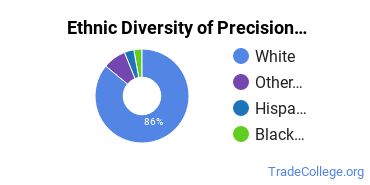Precision Production Schools in Missouri
574 Precision Production students earned their degrees in the state in 2021-2022.
In terms of popularity, Precision Production is the 5th most popular major in the state out of a total 7 majors commonly available.
Featured schools near , edit
Education Levels of Precision Production Majors in Missouri
Precision Production majors in the state tend to have the following degree levels:
| Education Level | Number of Grads |
|---|---|
| Award Taking 1 to 2 Years | 262 |
| Award Taking 2 to 4 Years | 262 |
| Award Taking Less Than 1 Year | 187 |
| Associate Degree | 125 |
Gender Distribution
In Missouri, a precision production major is more popular with men than with women.

Racial Distribution
The racial distribution of precision production majors in Missouri is as follows:
- Asian: 1.2%
- Black or African American: 3.7%
- Hispanic or Latino: 6.4%
- White: 82.9%
- Non-Resident Alien: 0.2%
- Other Races: 5.6%

Jobs for Precision Production Grads in Missouri
In this state, there are 51,800 people employed in jobs related to a precision production degree, compared to 2,235,350 nationwide.

Wages for Precision Production Jobs in Missouri
In this state, precision production grads earn an average of $37,730. Nationwide, they make an average of $40,790.

Most Popular Precision Production Programs in MO
There are 10 colleges in Missouri that offer precision production degrees. Learn about the most popular 10 below:
14 to 1 is the student to faculty ratio. Grads earn an average early-career salary of $27,446 after earning their degree at this institution. The 2.90% student loan default rate is lower than average.
14 to 1 is the student to faculty ratio. 100% of the teachers are full time. The 1.30% student loan default rate is lower than average.
Of all the teachers who work at the school, 60% are considered full time. Grads earn an average early-career salary of $46,934 after earning their degree at this institution. The student to faculty ratio is 12 to 1.
Students who attend this public school pay an average net price of $8,710. Of all the students who attend this school, 95% get financial aid. Of all the teachers who work at the school, 28% are considered full time.
This public college charges it's students an average net price of $13,336. 96% of students get financical aid. Graduates earn an average $47,255 after graduation.
This public school has an average net price of $6,782. Roughly six years after entering college, graduates of this school earn $30,281 a year. This school boasts a lower than average student loan default rate of 1.90%.
This public college charges it's students an average net price of $8,718. 90% of students are awarded financial aid at this school. 17 to 1 is the student to faculty ratio.
Roughly six years after entering college, graduates of this school earn $29,529 a year. A typical student attending Crowder College will pay a net price of $5,291. The student to faculty ratio is 13 to 1.
The student loan default rate of 2.50% is a good sign that graduates can afford their loan payments. Roughly six years after entering college, graduates of this school earn $28,867 a year. 17 to 1 is the student to faculty ratio.
100% of students are awarded financial aid at this school. Roughly six years after entering college, graduates of this school earn $33,306 a year. Students enjoy a student to faculty ratio of 7 to 1.
Precision Production Careers in MO
Some of the careers precision production majors go into include:
Related Majors in Missouri
Below are some popular majors in the state that are similar to precision production.
| Major | Annual Graduates in MO |
|---|---|
| Personal & Culinary Services | 1,495 |
| Mechanic & Repair Technologies | 1,051 |
| Transportation & Materials Moving | 465 |
| Construction Trades | 295 |
View all majors related to Precision Production
Explore Major by State
Alabama
Arkansas
Connecticut
Florida
Idaho
Iowa
Louisiana
Massachusetts
Mississippi
Nebraska
New Jersey
North Carolina
Oklahoma
Rhode Island
Tennessee
Vermont
West Virginia
View Nationwide Precision Production Report
References
More about our data sources and methodologies.
Featured Schools
 Request Info
Request Info
|
Southern New Hampshire University You have goals. Southern New Hampshire University can help you get there. Whether you need a bachelor's degree to get into a career or want a master's degree to move up in your current career, SNHU has an online program for you. Find your degree from over 200 online programs. Learn More > |

